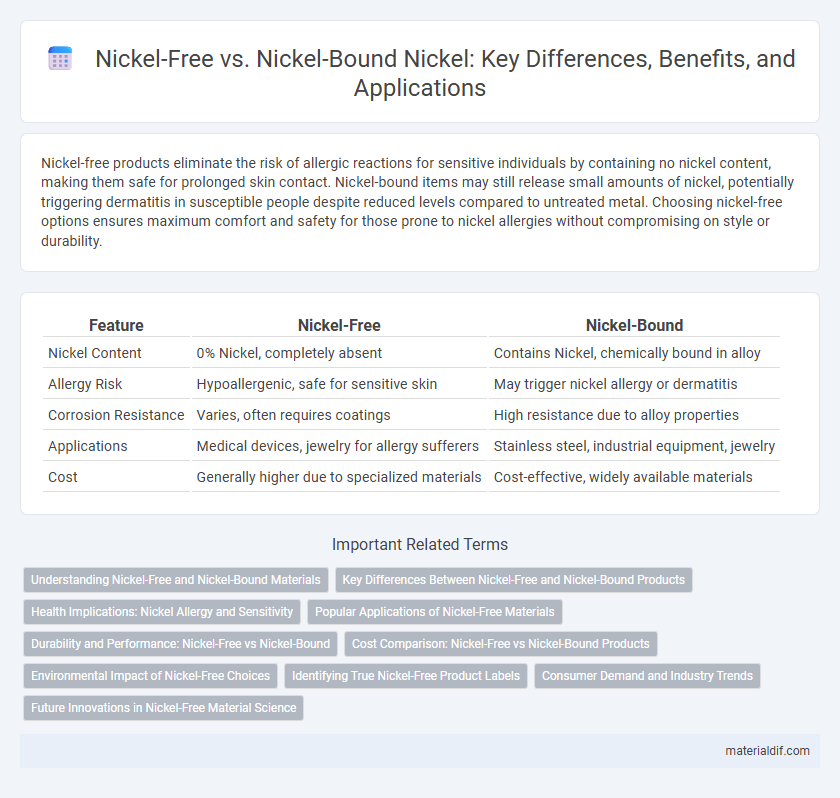Nickel-free products eliminate the risk of allergic reactions for sensitive individuals by containing no nickel content, making them safe for prolonged skin contact. Nickel-bound items may still release small amounts of nickel, potentially triggering dermatitis in susceptible people despite reduced levels compared to untreated metal. Choosing nickel-free options ensures maximum comfort and safety for those prone to nickel allergies without compromising on style or durability.
Table of Comparison
| Feature | Nickel-Free | Nickel-Bound |
|---|---|---|
| Nickel Content | 0% Nickel, completely absent | Contains Nickel, chemically bound in alloy |
| Allergy Risk | Hypoallergenic, safe for sensitive skin | May trigger nickel allergy or dermatitis |
| Corrosion Resistance | Varies, often requires coatings | High resistance due to alloy properties |
| Applications | Medical devices, jewelry for allergy sufferers | Stainless steel, industrial equipment, jewelry |
| Cost | Generally higher due to specialized materials | Cost-effective, widely available materials |
Understanding Nickel-Free and Nickel-Bound Materials
Nickel-free materials contain no nickel ions, making them ideal for individuals with nickel allergies or sensitive skin, while nickel-bound materials have nickel chemically or physically integrated within their composition. Understanding the difference is crucial for selecting hypoallergenic products, as nickel-bound items may release nickel over time, triggering allergic reactions. Testing methods such as patch testing and nickel release assays help determine the nickel content and potential allergenicity of these materials.
Key Differences Between Nickel-Free and Nickel-Bound Products
Nickel-free products contain no nickel metal, making them ideal for individuals with nickel allergies or sensitive skin, as they eliminate the risk of allergic reactions. In contrast, nickel-bound products include nickel combined with other metals or materials, which can sometimes release nickel ions leading to skin irritation or allergic responses over prolonged exposure. The primary difference lies in the presence and potential bioavailability of nickel ions, with nickel-free items offering safer alternatives for allergy prevention.
Health Implications: Nickel Allergy and Sensitivity
Nickel-free products are essential for individuals with nickel allergy or sensitivity, as exposure to nickel-bound items can trigger allergic contact dermatitis characterized by redness, itching, and swelling. Nickel-bound materials release nickel ions upon skin contact, increasing the risk of sensitization and exacerbating symptoms in susceptible individuals. Using nickel-free alternatives significantly reduces health risks and prevents chronic skin irritation associated with nickel hypersensitivity.
Popular Applications of Nickel-Free Materials
Nickel-free materials are widely used in medical implants, jewelry, and electronics where hypoallergenic properties are critical, minimizing the risk of skin irritation and allergic reactions. These materials offer enhanced biocompatibility, making them suitable for wearable devices and surgical tools that require direct and prolonged contact with human skin. Industries focusing on consumer safety increasingly prefer nickel-free alloys and coatings to comply with stringent regulations and improve user comfort.
Durability and Performance: Nickel-Free vs Nickel-Bound
Nickel-bound materials exhibit superior durability and corrosion resistance compared to nickel-free alternatives, making them ideal for high-performance industrial applications. Nickel-free products often prioritize hypoallergenic properties but may lack the long-lasting strength and wear resistance found in nickel-bound counterparts. Performance metrics in sectors like electronics, automotive, and aerospace consistently favor nickel-bound alloys for enhanced reliability and lifespan.
Cost Comparison: Nickel-Free vs Nickel-Bound Products
Nickel-free products often carry higher manufacturing costs due to the use of alternative hypoallergenic materials, resulting in increased retail prices compared to nickel-bound items. Nickel-bound products, commonly used in jewelry and electronics, benefit from nickel's affordability and widespread availability, making them cost-effective for mass production. Consumers seeking nickel-free options typically pay a premium to avoid allergic reactions, highlighting a clear trade-off between cost and skin safety.
Environmental Impact of Nickel-Free Choices
Nickel-free alternatives significantly reduce environmental pollution by eliminating nickel mining and processing, which contribute to soil degradation and water contamination. Choosing nickel-free materials decreases the release of toxic nickel compounds into ecosystems, promoting biodiversity and healthier water sources. This choice supports sustainable manufacturing practices by lowering the carbon footprint associated with nickel extraction and refining.
Identifying True Nickel-Free Product Labels
Nickel-free products contain no nickel ions released during use, critical for preventing allergic contact dermatitis in sensitive individuals. True nickel-free labels are verified through standardized tests like the dimethylglyoxime (DMG) test, which detects nickel release, ensuring consumer safety. Products labeled nickel-bound may still release trace nickel amounts, posing risks to nickel-sensitive users despite the absence of free nickel ions.
Consumer Demand and Industry Trends
Consumer demand for nickel-free products is rising sharply due to increased awareness of nickel allergies and regulatory restrictions, especially in the European Union and North America. Industry trends show a shift towards nickel-free alloys and coatings that maintain durability and corrosion resistance while eliminating nickel exposure risks. Manufacturers are investing in research to develop innovative nickel-bound alternatives that reduce allergenic potential without compromising performance.
Future Innovations in Nickel-Free Material Science
Future innovations in nickel-free material science aim to develop advanced alloys and coatings that maintain durability and corrosion resistance without nickel content, addressing allergy concerns. Researchers are exploring alternative metals such as titanium, cobalt, and novel composites to replicate nickel's desirable properties while enhancing biocompatibility. These breakthroughs could revolutionize industries including medical implants, electronics, and jewelry by providing safer, high-performance nickel-free solutions.
Nickel-Free vs Nickel-Bound Infographic

 materialdif.com
materialdif.com